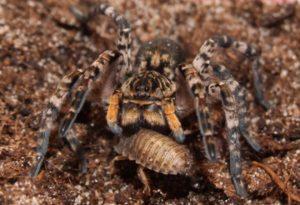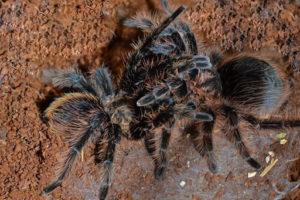Tarantula: photo of a spider with solid authority
Everyone knows such poisonous spiders as tarantulas. They differ in impressive sizes. One kind of spider leads to a state of fear and anxiety.
Content
Tarantula: photo
Description of the tarantula spider
Name: РўР ° СЂР ° нтулы
Latin: LycosaClass: Arachnida - Arachnida
Squad: Spiders - Araneae
 | Habitats: | steppe and forest-steppe |
 | Dangerous for: | small insects, amphibians |
 | Attitude towards people: | harmless, harmless |
The size of the tarantula is from 2 to 5 cm. The span of the legs is about 10 cm. Females are much larger than males. Females weigh about 30 grams. During the life cycle, the chitinous bristles are replaced several times. On four pairs of paws, bristles increase support when moving. Coloring can be brown, gray, black. Light individuals are less common.
Tarantula Diet
Venomous spiders feed on small insects and amphibians. caterpillars, crickets, bears, cockroaches, beetles, small frogs - the main food. They lie in wait for prey in a secluded place and act with poison. The poison is able to dissolve the internal organs, making them nutritious juice. After a while, tarantulas enjoy this energy cocktail.
Absorb food for several days. It is worth noting that the spider can live for a long time without food. It only needs water. One of the varieties was able to live without food for 2 years.
Habitat
Tarantulas prefer steppe, forest-steppe, desert, semi-desert climatic zones. The countries of residence include:
- Russia;
- Austria;
- Italy;
- Mongolia;
- Egypt;
- Hungary;
- China;
- Portugal;
- Algeria;
- Belarus;
- Spain;
- Ukraine;
- Libya
- Romania;
- Morocco;
- Greece;
- Sudan;
- Argentina;
- Uruguay;
- Brazil;
- Paraguay.
Of course, such a spider cannot be found in the area. Pacific Ocean.
Varieties of tarantulas
There are over 200 species. Of the most common, it is worth noting these prominent representatives.
Reproduction
In August, the mating season begins for tarantulas. Sexually mature male weaves spider webs on a flat flat surface. Then the male rubs his belly against the web until the seminal fluid erupts. After that, it is immersed in pedipalps.
The male is looking for a female and performs a kind of ritual. This is a marriage dance. If the female accepts courtship, then the male fertilizes her. After completing this stage, he needs to run faster so that the female does not eat him.
The female descends into a hole and is engaged in weaving a cocoon. There is a laying of 50 to 2000 eggs. For about 45 days, hatched individuals are on the mother's back. When they can feed themselves, they will leave their mother. They become sexually mature not earlier than the second year of life.
Tarantula Bite Danger
Spiders are not aggressive. They are unable to attack themselves. An attack can be provoked by sudden movements of a person near the hole. A healthy person should not be afraid of a spider. Allergy sufferers and children fall into the risk category.
Of the first symptoms of a bite, it is worth noting:
- local pain and redness of the skin;
- swelling;
- drowsiness and general malaise;
- a sharp increase in temperature;
- sometimes nausea, vomiting.
In this case, it is necessary to provide first aid:
- Wash the affected area with antibacterial soap.
- Treat the wound with an antiseptic.
- Cool the bite area with ice.
- Take antihistamines.
- Drink plenty of fluids to flush out toxins.
- They turn to a doctor.
https://youtu.be/6J6EjDz5Gyg
Interesting facts about tarantulas
Several features:
- tarantula blood is the antidote for spider bites. If you crush it, then you can smear the affected area with blood;
- tarantulas have the ability to regenerate lost limbs. When a paw is lost, a new one grows in time;
- on the branches of trees, they are held with claws;
- the skin of the abdomen is very thin. Breaks are possible with minor falls;
- males can travel long distances in search of females.
Conclusion
Tarantulas are not capable of attacking without a special reason. In case of a bite, first aid must be provided and go to the hospital. Despite the terrifying appearance of the tarantula, more and more fans have recently appeared who want to keep this type of spider as pets.
Previous

